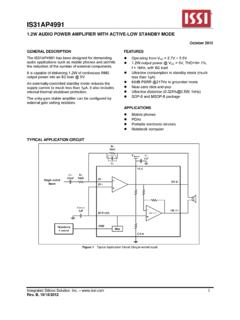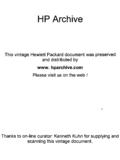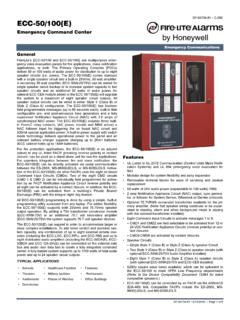Transcription of Quiver XT user guide v 1.2 - Arcom Digital
1 Quiver XT user guide Quiver 8/24/16 This document describes the operation and feature set of the Quiver XT. 2 Table of Contents Introduction.
2 4 Quiver Functional Overview .. 4 Navigation Buttons .. 4 Inputs and Outputs .. 5 Batteries .. 6 Startup .. 6 Brightness and Audio control .. 7 Settings .. 7 Settings General .. 8 Setting Up the FSK Data Carrier Band and FSK frequency .. 8 Settings Bluetooth (BT) name and pin .. 9 Background .. 10 Settings Measurement .. 10 Setting operation standards .. 10 Distance scale .. 11 Return 11 FWD scan list .. 11 Settings Calibration .. 12 Quiver XT Operation Modes .. 12 CPD Radar Mode .. 13 CPD Radar Connection Diagrams .. 14 Amplifier Connection.
3 16 Tap and Splitter Connection .. 17 End of Line CPD .. 18 Using CPD Radar in Local View .. 19 Selecting CPD detection filter bandwidth .. 20 Selecting noise suppression .. 21 Using the CPD Marker Option .. 22 Zoom mode in Passive radar .. 23 Filtering of analog channels IMPORTANT .. 25 Active radar mode .. 25 NTC TDR .. 26 Connecting to a line passive .. 29 Connecting to an amplifier .. 30 Connecting to a length of cable .. 31 Using the TDR .. 32 Check Spectrum .. 32 TDR Settings VOP .. 33 Cable .. 33 3 Recommended TDR signal level.
4 34 TDR run modes .. 34 Spectrum analyzer/Signal level meter modes .. 35 Return spectrum analyzer mode .. 35 LNA low noise amplifier .. 37 Reference level change .. 38 Scale change .. 38 Markers .. 39 Using Max Hold .. 40 Hold feature .. 41 Saving a Spectrum Analyzer Trace .. 42 Forward SLM/Spectrum mode .. 43 Examples of actual FWD spectrum signals .. 44 QAM demodulator mode .. 46 Using the Save Trace Option .. 47 Saving a Trace .. 47 Recalling a Trace .. 48 Clearing Traces .. 49 Downloading Traces .. 49 Using CPD Radar in Headend View .. 50 Calibrator Mode.
5 51 Calibrator Connection Diagrams .. 52 Nodes .. 52 Alternative Node Calibration .. 53 Amplifiers .. 54 Alternative Amplifier Connection .. 55 Splitters, Taps .. 56 Using Calibrator mode .. 56 Setting Up the Data Carrier Frequency .. 57 Setting the Signal Output Level .. 59 Calibrating a Fiber Node .. 60 Turning Calibrator Output Signal ON and OFF .. 60 Calibrating a Device Other Than the Fiber Node .. 63 Leakage Detector .. 65 Max Hold leak level .. 68 Saving and recalling the leakage trace .. 69 4 Introduction Quiver is a hand held, state of the art impairment locator designed to identify the distance to the fault for both linear and nonlinear distortions.
6 Quiver uniquely contains a CPD passive radar locator, a Network Traffic Compatible TDR, forward and return FFT spectrum analyzer, QAM demodulator, and leakage detector. Two version of Quiver XT are available, a standard version which works with the Hunter system, and an unbundled version for stand-alone operation. The standard version when used with Hunter provides a method of node calibration which allows for quicker and more efficient node scanning and additionally provides a means for the meter to display the impairment as seen as the headend, for confirmation of fix.
7 Quiver Functional Overview Quiver performs several functions that vary depending upon the operating mode you choose. Within each operating mode, various screens will appear in the Quiver display. All the navigation buttons are located on the lower portion of the unit. Navigation Buttons Power ON/OFF: To turn the unit on, press for 3 second; to turn the unit off, press and hold for 3 seconds and select Power down option. Select Standby for putting the meter into power saving state with fast launch. To wake up the unit from the Standby, press and hold the power button for 3 seconds.
8 If you hold it too long, the unit will shut down. 5 <ENTER>: Used to confirm changes and to enable some functions. Exit: press to exit the menu item, note some screens require pushing Back soft key instead. Cursors (arrow keys): Used for scrolling the screen and switching between functions.
9 Right below the screen window are four function keys that are related to information displayed on the screen. Inputs and Outputs Forward Signal Input: Connects to the forward test port at the amplifier or fiber node, or to one of the outputs of the QTP-20 Test Probe (used at any device that does not have a forward or return test port). 6 Return Signal Input: Serves as an input while in either Spectrum Analyzer or CPD Radar mode; serves as an output for the calibration signal when in Calibrator mode.
10 Battery charger input: Connector dedicated to charging the batteries using either the AC input charger which is supplied with the Quiver , or a car charger that can be purchased separately. Batteries The Quiver s battery pack contains Li-Ion batteries. For safety reasons, only use the supplied battery charger and do not replace the battery pack with any other batteries. Startup To turn on the Quiver , push the Power ON/OFF button and hold for 3 seconds. Once the unit is on, you will see the following screen, landing on the Operation modes page. 7 Brightness and Audio control Brightness and volume control is accesses by pressing the Brightness / Volume hot key accessed from the main menu page.








